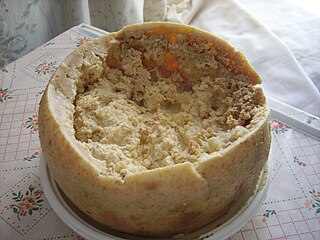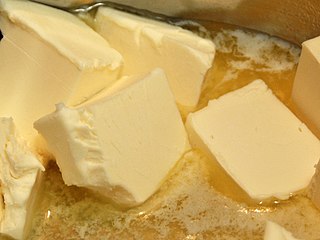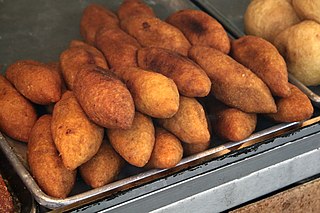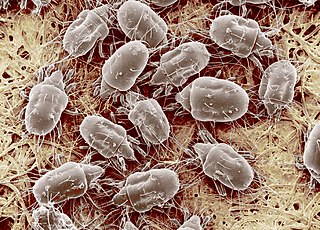
Cheddar cheese is a natural cheese that is relatively hard, off-white, and sometimes sharp-tasting. Cheddar originates from the English village of Cheddar in Somerset.

Mexican cuisine consists of the cooking cuisines and traditions of the modern country of Mexico. It's earliest roots lie in Mesoamerican cuisine, but also Iberian Europe. It's ingredients and methods originated with the first agricultural communities such as the Olmec and Maya who domesticated maize, created the standard process of nixtamalization, and established their foodways. Successive waves of other Mesoamerican groups brought with them their cooking methods. These included: the Teotihuacanos, Toltec, Huastec, Zapotec, Mixtec, Otomi, Purépecha, Totonac, Mazatec, Mazahua, and Nahua. With the Mexica formation of the multi-ethnic Triple Alliance, culinary foodways became infused.

Casu martzu, sometimes spelled casu marzu, and also called "casu modde", "casu cundídu" and "casu fràzigu" in Sardinian, is a traditional Sardinian sheep milk cheese that contains live insect larvae (maggots).

Butter is a dairy product made from the fat and protein components of churned cream. It is a semi-solid emulsion at room temperature, consisting of approximately 80% butterfat. It is used at room temperature as a spread, melted as a condiment, and used as a fat in baking, sauce-making, pan frying, and other cooking procedures.

Monterey Jack, sometimes shortened to Jack, is a US white, semi-hard cheese made using cow's milk, with a mild flavor and slight sweetness. It has been called "an American original" and "as a vestige of Spanish rule in the early nineteenth century, derives from a Franciscan monastic style of farmer's cheese."

Annatto is an orange-red condiment and food coloring derived from the seeds of the achiote tree, native to tropical parts of the Americas. It is often used to impart a yellow or orange color to foods, but sometimes also for its flavor and aroma. Its scent is described as "slightly peppery with a hint of nutmeg" and flavor as "slightly nutty, sweet and peppery".

Bixa orellana, also known as achiote, is a shrub native to Central America. Bixa orellana is grown in many countries worldwide.

Colby is a semihard orange cheese made from cow's milk. It is named after the city of Colby, Wisconsin, USA, where it was first developed in 1885 and quickly became popular.

Munster, Munster-géromé, or (Alsatian) Minschterkaas, is a soft cheese with a subtle taste, made mainly from milk first produced in the Vosges, between the Alsace-Lorraine and Franche-Comté regions in France. The name "Munster" is derived from the Alsace town of Munster, where, among Vosgian abbeys and monasteries, the cheese was conserved and matured in monks' cellars.
Havarti or cream havarti is a semisoft Danish cow's milk cheese. It can be sliced, grilled, or melted.

Cantal cheese is an uncooked firm cheese produced in the Auvergne region of central France: more particularly in the département of Cantal as well as in certain adjoining districts. Cantal cheese was granted Appellation d'Origine Contrôlée certification in 1956. One of the oldest cheeses in France, Cantal dates back to the times of the Gauls. It came to prominence when Marshal Henri de La Ferté-Senneterre served it at the table of Louis XIV of France. Senneterre is also responsible for the introduction of Saint-Nectaire and Salers.

Alcapurria is a popular fritter dish from Puerto Rico.

Muenster or munster is a semi-soft cheese from the United States. It is thought to be an imitation of the Alsatian washed-rind Munster cheese, introduced by German immigrants. It is distinct from the processed dairy food Sweet Muenster Cheese. Its name is not related to the German cities of Münster in Westphalia or in Lower Saxony or the Irish province of Munster, but rather to the city of Munster in Alsace, which was part of Germany at the time the cheese was introduced in the US by German immigrants, but is now in France.

Haitian cuisine consists of cooking traditions and practices from Haiti. It is a Creole cuisine that originates from a blend of several culinary styles that populated the western portion of the island of Hispaniola, namely African, French, indigenous Taíno, Spanish and Arab influences. Haitian cuisine has some similarities with "criollo" cooking and similar to the rest of the Latin Caribbean, but differs in several ways from its regional counterparts. Flavors are bold and spicy demonstrating African and French influences, with notable derivatives coming from native Taíno and Spanish techniques.

There are many different types of cheese. Cheeses can be grouped or classified according to criteria such as length of fermentation, texture, methods of production, fat content, animal milk, and country or region of origin. The method most commonly and traditionally used is based on moisture content, which is then further narrowed down by fat content and curing or ripening methods. The criteria may either be used singly or in combination, with no single method being universally used.

The flour mite, Acarus siro, a pest of stored grains and animal feedstuffs, is one of many species of grain and flour mites. An older name for the species is Tyroglyphus farinae.

Cheese mites are mites that are used to produce such cheeses as Milbenkäse, Cantal and Mimolette. The action of the living mites on the surface of these cheeses contributes to the flavor and gives them a distinctive appearance. A 2010 scanning electron microscope study found that Milbenkäse cheese was produced using Tyrophagus casei mites, while Mimolette cheese used Acarus siro mites. Mimolette cheese, in particular, has live cheese mites in its rind which is thought to contribute to the cheese's distinct rind texture.
Some arachnids may be used for human consumption, either whole or as an ingredient in processed food products such as cheese (Milbenkäse). Arachnids include spiders, scorpions, and mites.
















